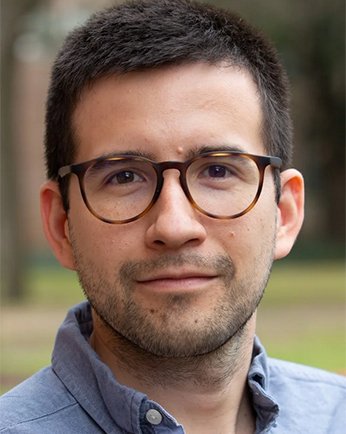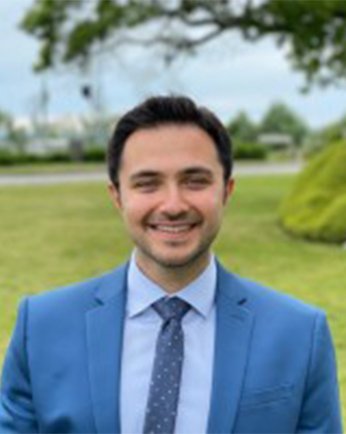Session Abstracts:

Graduate Student Researcher
Rice University
Resilience Assessment of Networked Systems Through Model Integration and Model Interoperability
Co-Authors: Jamie Padgett (Rice University) and Stanley C. Moore (Rice University)
Abstract: Resilience assessments on networked systems present different challenges from a computational perspective. First, a set of computational sub-models must be available to simulate the multi-level outcomes needed to characterize spatially distributed hazards, components’ performance, and system recovery models, to name a few. Second, uncertainty quantification in resilience assessment demands high-performance computing (HPC) to alleviate the large computational time of the thousands to millions of simulations the analysis requires. Finally, big data storage is required during and after the assessment for the posterior analysis of intermediate and final outcomes, visualization of results, and data sharing. This presentation demonstrates how the DesignSafe Cyberinfrastructure (DesignSafe-CI) and the Texas Advanced Computing Center (TACC) help overcome such challenges. We present how a seamless interaction between data and models available within and outside the DesignSafe-CI, for example, IN-CORE models and tools, supports and enhances community resilience assessments. A hypothetical transportation network of Memphis Metropolitan and Statistical Area (MMSA), subjected to seismic events, is used for illustrative purposes. By exploiting the interoperability of DesignSafe JupyterHub and pyincore module (from the IN-CORE platform) and by leveraging parallel computing capabilities, high-speed memory access, and big data storage capabilities at DesignSafe-CI, a risk and resilience analysis over the MMSA transportation network is presented. We center the examples on the benefits of enabling interoperability between the platforms to enable scientific advancements and ease practical applications in the natural hazards community.

Assistant Professor
Old Dominion University
Physical-Social Community Resilience Simulation and Validation via Longitudinal Tornado Reconnaissance Studies
Co-Authors: John W. van de Lindt (Colorado State University), Blythe Johnston (Colorado State University), P. Shane Crawford (University of Alabama), and Guirong Yan (Missouri University of Science and Technology)
Abstract: As social needs and public expectations rise, stakeholders must extend their focus beyond merely addressing the response and recovery of physical buildings and infrastructures affected by natural hazards. Analysts are now required to model communities as interconnected physical and socio-economic systems and assess multidisciplinary and multidimensional resilience metrics. Community-level simulations will be far more convincing to stakeholders, planners, and engineers when applied to real communities to forecast or hindcast outcomes from actual hazard events, provided they are robustly validated through field investigations. However, although both simulations and validations at a community scale mentioned above have appeared in recent years, they still need to be improved due to the complexity of multidisciplinary algorithm fusions and the challenges of reliable data acquisition. Mayfield, Kentucky, was hit by a long-track EF4 tornado and was one of the communities most heavily damaged during the 2021 Midwest Tornado Outbreak. This presentation will introduce the development of building and housing unit inventory for Mayfield, predict building damage, household disruption, and building recovery following the tornado using the IN-CORE computational environment, and validate the analytical simulations via longitudinal tornado reconnaissance studies. The proposed studies aim to enhance community resilience modeling to be more generalized and applicable and provide valuable decision-making support to other similarly sized communities.

Postdoctoral Scholar
University College London
Modeling and Computational Challenges in Post-disaster Building Recovery under Multiple Hazard Scenarios
Co-Authors: Carmine Galasso (University College London) and Carlos Molina Hutt (University of British Columbia)
Abstract: Recent disasters (e.g., the 2023 Türkiye-Syria earthquake and floods) have underscored the potential for multiple natural hazards occurring during a community’s recovery, further prolonging post-disaster recovery times. This study investigates modeling and computational challenges involved in assessing post-disaster recovery trajectories for building structures subjected to plausible initial and secondary hazard scenarios by accounting for various interarrival times and relative intensities (in terms of event mean return period). An illustrative example of a building subjected to an earthquake followed by a flood scenario (with explicit consideration of climate change effects on the flood’s severity and frequency) is showcased by discussing relevant post-disaster delays that occurred before the start of repairs (i.e., impeding factor delays) for each hazard scenario and the impact of the secondary event on the recovery trajectory. For instance, financing through insurance settlement for two hazard events occurring within a short time frame (weeks or months) could be complex and require a much longer time to settle, which then impedes the recovery of the asset. Furthermore, the impact of different damage levels (and corresponding repair classes) to critical structural/non-structural components across both hazards, as well as their potential interactions, on the recovery trajectory is investigated. Finally, this study examines how various policy decisions made at different stages post-disaster influence recovery trajectories. It highlights the complexities and significant uncertainties involved in decision-making, such as delays caused by impeding factors and their interactions under extreme and unexpected secondary events. This understanding can aid in developing dynamic and adaptive policy pathways.

Graduate Student Researcher
University of Nebraska-Lincoln
Leveraging Machine Learning and AI for Enhanced Tornado Resilience in Community Infrastructure
Co-Authors: Milad Roohi (University of Nebraska-Lincoln)
Abstract: Tornadoes are one of the most devastating natural hazards and pose a significant threat to communities not well-prepared in infrastructure, technology, and resources. With climate change influencing the wind related hazards, the complexity of the hazard is increasing and traditional approaches to resilience, which itself is a novel and evolving field, lack the ability to parallelly improve with advancements in predictive modeling and infrastructure design. This is due to several factors such as uniqueness in infrastructure, socio-economic makeup and geolocation of the distinct communities. A general framework that provides communities with technologies adapted to their unique vulnerabilities and characteristics is presented in this research. This facilitates optimizing the infrastructure design, response strategies and recovery efforts.
The research provides a novel and innovative approach in integrating machine learning (ML) and artificial intelligence (AI) to advanced platforms including IN-CORE and DesignSafe for data fusion from diverse data sources. Those can be historical hazard data, climate prediction models, building inventory dataset, socio-economic and demographic data. This provides a framework for a unified resilience modeling platform. The integrated approach identifies the most vulnerable areas within a community and optimizes preparedness, response, resource allocation and recovery pathways. The research highlights the framework’s ability to seamlessly integrate into existing communities and facilitates data-sharing on the already available platform to inform decisions for other communities. This research underscores the potential of new technologies in informing how the communities prepare, respond and recover. The integrated data fusion approach is applicable to other hazards too.

Graduate Student Researcher
Louisiana State University
Uncovering Social Inequities in Flood Risk: A Bayesian Network Analysis for Urban Vulnerability
Co-Authors: Sabarethinam Kameshwar (Louisiana State University), Md Adilur Rahim (Louisiana State University-AgCenter), and Carol Friedland (Louisiana State University-AgCenter)
Abstract: Regional flood risk assessment requires understanding the complex interplay of socio-demographic, economic, hydro-geologic, and climatic variables that impact flood vulnerability. Traditional studies often focus on large-scale geographic units or generalized socio-demographic characteristics, overlooking localized variations that reveal disproportionate flood exposure among socially vulnerable populations. To address these gaps, a flood risk assessment for East Baton Rouge, Louisiana, is conducted for the August 2016 flood event using a Bayesian Network approach to identify relationships between different variables at the housing unit level. In addition, this study identifies Flood Exposure Representativeness (FER) using the Bayesian Network’s forward and backward inference capabilities to determine which groups (race, income, ownership status) are overrepresented or underrepresented. This study considers socio-demographic and economic (race, ownership, income group), hydro-geologic (land cover, waterbody proximity, ground elevation, water depth, building foundation height), and climatic (rainfall) factors for flood risk assessment. The IN-CORE housing unit allocation methodology and Monte Carlo simulation are utilized to process socio-economic and demographic data at the housing unit level, while geospatial methods are used to process other variables. Datasets are divided into training and testing sets, and the Maximum Likelihood Algorithm is applied to train the Bayesian Network. Results highlight disproportionate risks faced by specific racial (i.e., White and Black Americans) and income (i.e., high-income) groups. This work advances flood risk assessment by integrating high-resolution and multivariable data, offering critical insights into the impacts on vulnerable socio-demographic and economic groups. The methodology enables targeted, equitable flood risk mitigation and informs resilient urban planning strategies.

Assistant Professor
George Mason University
Role of Mangrove Forests in Housing Infrastructure Resilience During Tropical Storms
Co-Authors: Amirhossein Chegini (George Mason University)
Abstract: Coastal vegetation serves as a crucial defense against tropical storms, shielding communities worldwide from the severe impacts of these extreme events. In particular, the presence of mangrove forests has been observed to reduce structural damage in near-shore houses. As climate change intensifies the frequency and strength of tropical cyclones, understanding the risk mitigation effects of coastal vegetation—and the factors influencing this potential—is vital for developing adaptation strategies and enhancing coastal resilience. While the capacity of mangrove forests to attenuate waves and storm surges is well-documented, the effects of factors like mangrove height, density, cross-shore thickness, and proximity to residential buildings on sustained wave loads remain poorly understood.
This study employs a parametric modeling strategy to quantify uncertainties and evaluate the load demand on a prototype coastal house under hurricane wave conditions. It considers variables such as excitation intensity, mangrove stem length, cross-shore thickness, density, and the house’s distance from the forest. To enhance the analysis and visualization of these complex interactions, we leverage DesignSafe’s Jupyter Hub to create a Jupyter Notebook for post-processing and visualization. This interactive platform integrates numerical model results, allowing users to explore how different mangrove configurations and storm intensity parameters affect housing infrastructure resilience.
The results underscore the interdependencies between natural and built system vulnerabilities and provide a data visualization framework that enables users to easily understand the effects of varying mangrove forest characteristics on structural vulnerability. This work aims to support the broader adoption of nature-based and hybrid solutions for climate change adaptation.